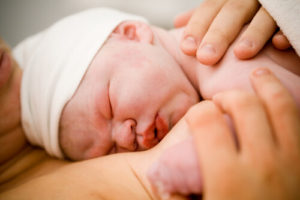Jaundice and Kernicterus

Kernicterus causes a visible yellowing or jaundice of both the skin and the whites of the eyes in newborns. Jaundice occurs when a chemical called bilirubin builds up in a child’s blood. During gestation, a mother’s liver functions to remove bilirubin from her baby’s bloodstream are not performing properly. After birth the baby’s liver must compensate and start performing this function on its own. Yet in some newborns, the liver may not be fully developed in order to allow the child to efficiently rid itself of the excess bilirubin in his or her system.
While about 60 percent of children in the United States are born each year with a slight yellowing of the skin, kernicterus refers to a situation in which severe jaundice remains undiagnosed and untreated for a dangerously long period of time, resulting in potential brain damage and other serious complications such as cerebral palsy and hearing loss. If your child sustained birth injuries due to undiagnosed or untreated jaundice, please call Stern Law, PLLC at (800) 462-5772 for free to discuss your legal options.
What are the signs and symptoms of kernicterus?
The signs and symptoms associated with jaundice typically manifest on the face and then migrate to the whites of the eyes, chest, abdomen, arms and legs as the bilirubin levels continue to increase. The following symptoms suggest that a child is suffering from kernicterus:
- Very yellow or orange skin color that start from the head and spread to the toes;
- Irritability;
- A child who does not sleep or is hard to arouse;
- Extreme lethargy;;
- Fever;
- Seizures;
- Dehydration;
- Extreme fussiness;
- Consistent dry diapers;
- A high pitched and inconsolable cry;
- A body arched like a bow where the head or neck and heels are bent backwards while the body protrudes forward;
- Limpness, stiffness or a “floppy” body;
- Irregular eye movements.
Early detection and management of newborn jaundice can easily prevent further complications from occurring, including the onset of kernicterus. If your newborn is showing signs of jaundice, it is recommended that you seek medical attention immediately.
What are the risk factors associated with kernicterus?
The majority of all children born in the United States have some degree of jaundice. Some children are more likely than others to experience dangerous levels of bilirubin in their systems, requiring close monitoring and symptom management. The following are the most common risk factors associated with kernicterus:
- Premature babies – A child born before 37 weeks of gestation is at a greater risk of developing jaundice, as his or her liver may not be fully developed and able to rid itself of excess bilirubin levels;
- East Asian or Mediterranean descent – A child born to a family of these two origins is more likely than others to develop jaundice at birth. Certain families inherit conditions such as glucose-6-phosphate dehydrogenase, or G6PD, deficiency resulting in a higher likelihood that a child will develop jaundice as a newborn;
- Genetics – Certain genetic diseases such as Crigler-Najjar syndrome or Gilbert’s syndrome may cause jaundice in newborns;
- A sibling with jaundice – A newborn with a brother or sister who had jaundice is much more likely to develop the condition as a result;
- Bruising – A baby who is born with bruising at birth may develop jaundice more readily than others. A bruise forms when blood leaks out of a blood vessel due to a trauma, often due to the usage of medical instruments to facilitate a vaginal delivery, and causes the surface of the skin to appear black and blue. As large bruises heal, they can cause excess levels of bilirubin to form in the body, resulting in jaundice;
- Blood type – When a mother has O positive blood or in a case of Rh incompatibility, she has a greater chance of giving birth to a child with higher than normal bilirubin levels;
- Difficulty with feeding – A child who is not eating and passing urine or stool within the first few days of life is at a greater risk of developing jaundice, since these mechanisms aid in the excretion excess bilirubin levels on the body.
How is jaundice/kernicterus diagnosed?
Before being discharged from the hospital with your new baby, a doctor should check the child’s bilirubin levels, which is typically performed as follows:
- Transcutaneous bilirubin, or TcB, level test – This procedure involves the use of a light meter that is placed on a newborn’s head in order to determine whether a child has excess bilirubin levels in his or her system. If the meter reading is elevated, a blood test will likely be necessary to assess the severity of the condition;
- Total serum bilirubin, or TSB, level test – The most accurate way to check for excess bilirubin levels is to take a small blood sample from a baby’s heel after he or she is born. If a child’s blood bilirubin levels are high, repeat blood samples will be necessary to determine the most appropriate course of treatment, as it will indicate a potentially worsening condition. To illustrate, bilirubin levels are typically the highest when a baby is between three to five days old. If a child experiences jaundice, he or she should be monitored and tested repeatedly to monitor and treat the condition, especially if symptoms have not improved on their own.
If your child suffered complications after delivery due to jaundice and you believe medical negligence is to blame, please call Stern Law, PLLC at (800) 462-5772 for a free consultation.







